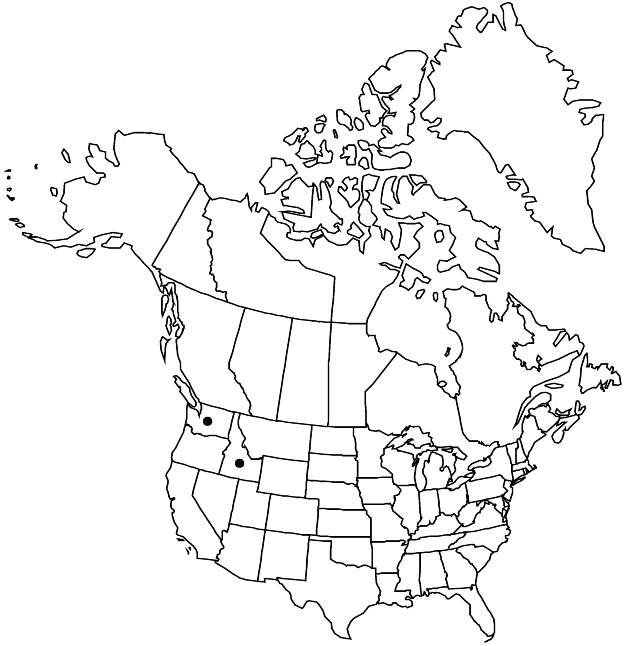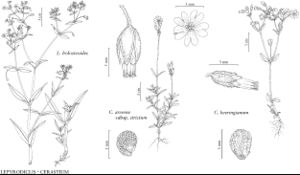Difference between revisions of "Lepyrodiclis holosteoides"
Enum. Pl. Nov. 1: 93, 110. 1841.
FNA>Volume Importer |
imported>Volume Importer |
||
| (3 intermediate revisions by 2 users not shown) | |||
| Line 6: | Line 6: | ||
|place=1: 93, 110. 1841 | |place=1: 93, 110. 1841 | ||
|year=1841 | |year=1841 | ||
| + | }} | ||
| + | |special_status={{Treatment/ID/Special_status | ||
| + | |code=W | ||
| + | |label=Weedy | ||
| + | }}{{Treatment/ID/Special_status | ||
| + | |code=I | ||
| + | |label=Introduced | ||
| + | }}{{Treatment/ID/Special_status | ||
| + | |code=F | ||
| + | |label=Illustrated | ||
}} | }} | ||
|basionyms={{Treatment/ID/Basionym | |basionyms={{Treatment/ID/Basionym | ||
|name=Gouffeia holosteoides | |name=Gouffeia holosteoides | ||
|authority=C. A. Meyer | |authority=C. A. Meyer | ||
| + | |rank=species | ||
|publication_title=Verz. Pfl. Casp. Meer., | |publication_title=Verz. Pfl. Casp. Meer., | ||
|publication_place=217. 1831 | |publication_place=217. 1831 | ||
| Line 28: | Line 39: | ||
|elevation=500-800 m | |elevation=500-800 m | ||
|distribution=Idaho;Wash.;c;sw Asia;introduced in Europe (Germany);Asia (Japan). | |distribution=Idaho;Wash.;c;sw Asia;introduced in Europe (Germany);Asia (Japan). | ||
| + | |introduced=true | ||
|discussion=<p>Although known in North America only since 1959, <i>Lepyrodiclis holosteoides</i> is a serious menace in pea and wheat plantings, where it grows quickly and often overtops the crops. It is listed as a noxious weed in Washington and Oregon; I am not aware of any documented occurrences in Oregon.</p><!-- | |discussion=<p>Although known in North America only since 1959, <i>Lepyrodiclis holosteoides</i> is a serious menace in pea and wheat plantings, where it grows quickly and often overtops the crops. It is listed as a noxious weed in Washington and Oregon; I am not aware of any documented occurrences in Oregon.</p><!-- | ||
--><p>If <i>Lepyrodiclis</i> stellarioides Schrenk ex Fischer & C. A. Meyer is included as a variety of <i>L. holosteoides</i> (see Y. P. Kozhevnikov 1985), North American plants are var. holosteoides</p> | --><p>If <i>Lepyrodiclis</i> stellarioides Schrenk ex Fischer & C. A. Meyer is included as a variety of <i>L. holosteoides</i> (see Y. P. Kozhevnikov 1985), North American plants are var. holosteoides</p> | ||
| Line 38: | Line 50: | ||
-->{{#Taxon: | -->{{#Taxon: | ||
name=Lepyrodiclis holosteoides | name=Lepyrodiclis holosteoides | ||
| − | |||
|authority=(C. A. Meyer) Fenzl ex Fischer & C. A. Meyer | |authority=(C. A. Meyer) Fenzl ex Fischer & C. A. Meyer | ||
|rank=species | |rank=species | ||
| Line 53: | Line 64: | ||
|publication title=Enum. Pl. Nov. | |publication title=Enum. Pl. Nov. | ||
|publication year=1841 | |publication year=1841 | ||
| − | |special status= | + | |special status=Weedy;Introduced;Illustrated |
| − | |source xml=https:// | + | |source xml=https://bitbucket.org/aafc-mbb/fna-data-curation/src/2e0870ddd59836b60bcf96646a41e87ea5a5943a/coarse_grained_fna_xml/V5/V5_155.xml |
|subfamily=Caryophyllaceae subfam. Alsinoideae | |subfamily=Caryophyllaceae subfam. Alsinoideae | ||
|genus=Lepyrodiclis | |genus=Lepyrodiclis | ||
Latest revision as of 22:09, 5 November 2020
Stems 40–100 cm, glabrous or papillate. Leaf blades 1–8 × 0.3–1 cm, margins glandular-dentate. Flowers: sepals 4–5 mm; petals 1–1.5 times as long as sepals. Capsules globose-ovoid, 3 mm, shorter than calyx. Seeds 1.8–2 mm. 2n = 34, 68 (both Asia).
Phenology: Flowering spring.
Habitat: Disturbed areas, pea and wheat fields
Elevation: 500-800 m
Distribution

Introduced; Idaho, Wash., c, sw Asia, introduced in Europe (Germany), Asia (Japan).
Discussion
Although known in North America only since 1959, Lepyrodiclis holosteoides is a serious menace in pea and wheat plantings, where it grows quickly and often overtops the crops. It is listed as a noxious weed in Washington and Oregon; I am not aware of any documented occurrences in Oregon.
If Lepyrodiclis stellarioides Schrenk ex Fischer & C. A. Meyer is included as a variety of L. holosteoides (see Y. P. Kozhevnikov 1985), North American plants are var. holosteoides
Selected References
None.
